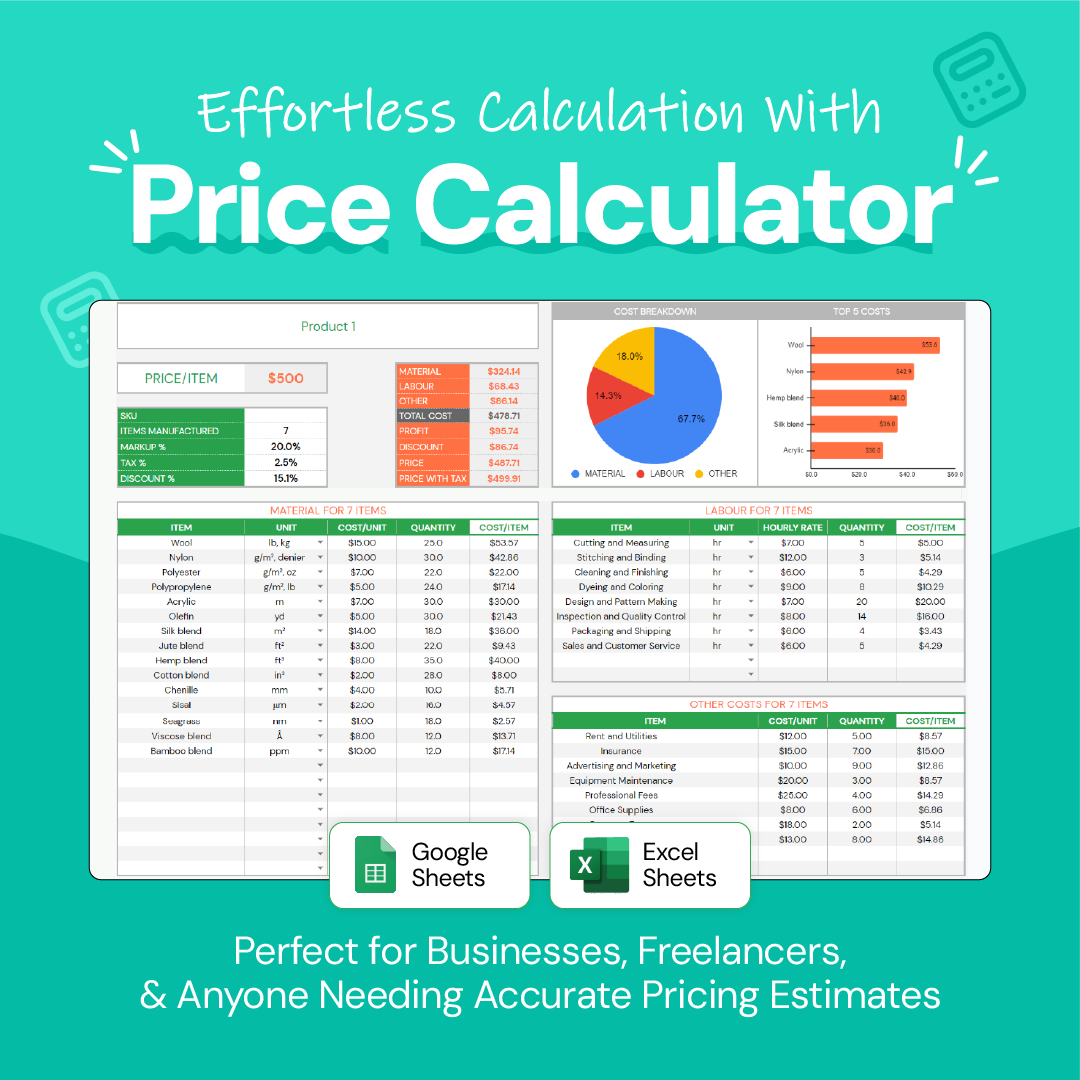Optimize Your Pricing with the Right Product Cost Calculators

Understanding the Importance of Accurate Product Costing
For any product based startup or a businness, accurately determining the cost of your products is essential. Knowing the true cost allows you to set competitive prices, maximize profits, and make informed pricing decisions. Without a clear understanding of the cost of your products, you may be leaving money on the table or unintentionally undercutting your profitability.
Product costing goes beyond simply calculating the direct cost of materials and labor. It takes into account overhead expenses, such as rent, utilities, and depreciation, that are necessary for the production process. By accurately allocating these costs to each product, you can gain a comprehensive view of your expenses and determine a fair price that covers all your costs and provides a reasonable profit margin.
Accurate product costing helps you identify cost-saving opportunities and improve efficiency. By analyzing the cost breakdown of each product, you can pinpoint areas where expenses can be reduced or processes can be streamlined. This not only increases profitability but also enhances your competitiveness in the market.
The Role of Product Costing in Business Strategy
Product costing plays a crucial role in shaping your overall business strategy. By understanding the costs associated with each product, you can make informed decisions on pricing, production volumes, and resource allocation. It helps you identify areas where costs can be reduced or efficiencies can be improved, leading to increased profitability.
An accurate product costing system enables you to evaluate the profitability of different product lines or customer segments. It provides insights into which products are generating the most revenue and which may be dragging down overall profitability. Armed with this knowledge, you can prioritize your efforts and focus resources on the most profitable areas of your business.
Product costing allows you to assess the impact of external factors on your pricing strategy. For example, if there is a sudden increase in the cost of raw materials, an accurate product costing system will help you determine whether you need to adjust your prices to maintain profitability or explore alternative sourcing options.
How Product Costing Impacts Pricing Decisions
Pricing decisions are critical to the success of any business. Setting prices too high can deter customers and limit market share, while pricing too low can erode profitability. Accurate product costing provides the foundation for making well-informed pricing decisions that strike the right balance between customer value and profitability.
By incorporating product costing data into your pricing strategy, you can ensure that your prices are competitive and cover all costs associated with producing and delivering your products. This allows you to avoid selling products at a loss or undercharging for their value. Additionally, product costing enables you to set prices that align with your business goals, whether that be maximizing market share, targeting premium customers, or optimizing profit margins.
Product costing helps you assess the impact of pricing changes on your overall profitability. By simulating different pricing scenarios based on accurate cost data, you can evaluate the potential outcomes and make data-driven decisions. This allows you to adapt to market dynamics and stay ahead of your competitors.
The Basics of Product Cost Calculators
Product cost calculators are powerful tools that help streamline the process of determining product costs. They automate complex calculations and provide accurate cost estimates quickly, allowing you to make timely pricing decisions. Understanding the basics of these calculators is essential in order to leverage their full potential.
Defining Product Cost Calculators
A product cost calculator is a software application or tool that calculates the total cost of producing a product. It takes into account various cost factors, such as raw materials, direct labor, overhead expenses, and any other costs associated with the production process. With a product cost calculator, you can easily input relevant information about your product and obtain an accurate cost estimate.
These calculators are often customizable and can be tailored to meet the specific needs of your business. They allow you to account for different cost structures, production methods, and cost drivers specific to your industry. By providing a comprehensive view of your costs, product cost calculators empower you to make data-driven pricing decisions.
Key Features of Effective Product Cost Calculators
While product cost calculators can vary in functionality and features, there are several key attributes that make them effective tools for optimizing your pricing strategy:
Ease of Use: A good product cost calculator should be intuitive and user-friendly. It should allow you to input relevant data easily and generate cost estimates with minimal effort.
Accuracy: A reliable product cost calculator should provide precise calculations, taking into account all cost factors and allowing for adjustments and customization as needed.
Flexibility: A product cost calculator should be adaptable to different scenarios and allow for customization to reflect your specific business requirements.
Data Integration: Seamless integration with existing data sources, such as your inventory management system or supplier databases, can enhance the accuracy and efficiency of cost calculations.
Reporting and Analysis: An effective product cost calculator should provide clear and concise reports, allowing you to analyze costs, compare scenarios, and make informed decisions based on real-time data.
Advanced product cost calculators may offer additional features such as:
Cost Sensitivity Analysis: Assess the impact of changes in cost factors on your overall product cost. By adjusting variables such as raw material prices or labor costs, you can evaluate different scenarios and identify potential cost-saving opportunities.
What-If Scenarios: Simulate different production scenarios and evaluate their impact on product cost. By adjusting variables such as production volume, machine utilization, or supplier costs, you can explore various possibilities and identify the most cost-effective options.
Choosing the Right Product Cost Calculator for Your Business
Now that you understand the importance and benefits of using a product cost calculator, it is crucial to choose the right one for your business. Consider the following factors when selecting a product cost calculator:
Factors to Consider When Selecting a Product Cost Calculator
Functionality: Evaluate the features and capabilities of different product cost calculators to ensure they align with your specific needs. Consider factors such as ease of use, customization options, and integration capabilities.
Scalability: Choose a product cost calculator that can scale with your business as it grows. Ensure that it can handle increasing data volumes and accommodate changes in your cost structure.
Vendor Reputation: Research the reputation and track record of the software vendor offering the product cost calculator. Look for testimonials, case studies, and customer reviews to gauge the reliability and satisfaction levels of existing users.
Customer Support: Consider the level of customer support provided by the product cost calculator vendor. Ensure that they offer reliable technical support and timely assistance whenever needed.
Pricing: Evaluate the pricing model of the product cost calculator, taking into account both the initial investment and ongoing maintenance costs. Consider whether the benefits and value provided by the tool justify the investment.
Common Mistakes to Avoid When Choosing a Product Cost Calculator
Overlooking Customization: One-size-fits-all calculators may not accurately reflect your unique cost structures or production methods. Ensure that the calculator you choose allows for sufficient customization.
Ignoring User Experience: Using a product cost calculator should be a seamless experience. Avoid tools that are overly complex or difficult to navigate, as they may hinder user adoption and productivity.
Falling for Low-Cost Solutions: While cost is an important consideration, don't compromise on quality and functionality for the sake of a lower price. Investing in a reliable and feature-rich product cost calculator can yield significant returns in the long run.

Implementing Product Cost Calculators in Your Pricing Strategy
Once you have selected the right product cost calculator for your business, the next step is to integrate it into your pricing strategy effectively. By following a systematic approach, you can maximize the value derived from this powerful tool.
Steps to Utilize a Product Cost Calculator into Your Business
Define Your Objectives: Clearly outline your pricing objectives and goals. Whether you aim to increase profitability, gain market share, or attract specific customer segments, aligning your pricing strategy with these objectives is critical.
1. Set Up Data Inputs: Ensure that you have accurate and up-to-date data inputs for your product cost calculator. This includes information such as raw material prices, labor costs, overhead expenses, and any other relevant data points.
2. Customize the Calculator: Tailor the product cost calculator to your specific business requirements. Customize cost drivers, production methods, and other variables to reflect the unique aspects of your operations.
3. Train and Educate Staff: Provide comprehensive training to your employees on effectively using the product cost calculator. Explain the importance of accurate product costing and how it aligns with pricing decisions.
4. Monitor and Evaluate: Regularly monitor the performance of your pricing strategy using the product cost calculator. Analyze cost data, evaluate profit margins, and assess the impact of various pricing decisions. Make adjustments as necessary to optimize your pricing strategy.
Monitoring and Adjusting Your Pricing Strategy with a Product Cost Calculator
A product cost calculator is not a set-it-and-forget-it tool. It requires ongoing monitoring and adjustment to ensure its effectiveness in optimizing your pricing strategy. By leveraging the real-time data provided by the calculator, you can stay agile and make informed pricing decisions.
Regularly review cost reports generated by the calculator and compare them to your desired profit margins and pricing objectives. Identify areas where costs can be reduced, efficiency can be improved, or pricing adjustments may be necessary. Continuously monitor market trends, competitor pricing, and customer feedback to stay ahead of the curve and adapt your pricing strategy accordingly.
The Future of Product Cost Calculators
As technology continues to advance, the future of product cost calculators looks promising. Emerging trends are shaping the way businesses calculate and manage their product costs, leading to more accurate and efficient pricing strategies.
Emerging Trends in Product Cost Calculation
Spreadsheets Tailored and Designed by Experts: Expertly designed spreadsheets can automate data analysis and decision-making processes, making cost calculations even more accurate and efficient.
Cloud-based Solutions: Cloud computing enables real-time collaboration and access to product cost data across different departments and locations, facilitating seamless integration and information sharing.
Integrated Analytics: Advanced analytics capabilities, such as predictive modeling and scenario analysis, can provide deeper insights into cost drivers, allowing businesses to proactively optimize their pricing strategy.
How Technological Advancements are Shaping Product Cost Calculators
Technological advancements are revolutionizing the way product cost calculators operate:
1. Improved Accuracy: Advanced algorithms and data integration capabilities help reduce the margin of error in cost calculations, resulting in more accurate pricing decisions.
2. Increased Efficiency: Automation and streamlined processes save time and resources, allowing businesses to calculate product costs more efficiently and focus on value-added activities.
3. Enhanced Collaboration: Cloud-based solutions enable real-time collaboration, empowering teams to work together seamlessly and make informed pricing decisions collectively.
By embracing these emerging trends and staying updated with the latest advancements, businesses can optimize their pricing strategies and adapt to the evolving market dynamics.
